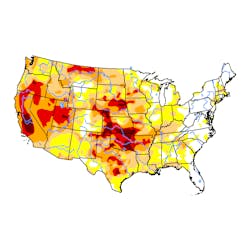Taking Pressure Off the Restroom’s Water-Saving Efforts
By Mike Gembarski
As of April, over 21% of the United States population—and 50.8 million people—are impacted by drought-like conditions.
This harsh reality is a problem both in the US and internationally. In fact, as of last year, several European countries were experiencing their worst droughts in nearly a century, causing major rivers to run dry.
Worldwide, more than 2.3 billion people face water stress, and almost 160 million children are exposed to severe and prolonged droughts. These droughts are not sudden, rogue occurrences—they’re a continuation of trends over the last few years, and these conditions are likely to persist well into the future.
That’s why water conservation is so important, and the restroom plays a unique role in this solution. With the restroom as the second-most visited space in any commercial building—and residential toilets accounting for nearly 30% of a home’s indoor water consumption—water-saving technology can go a long way.
There’s one water-saving innovation that builders and property owners can install in virtually any apartment complex, hotel, restaurant, or other public venue—or even private homes: pressure-assisted toilets.
Pressure-assisted Flushing at a Glance
Most ordinary toilets use gravity to flush their contents. When a flush is triggered, the water in the tank essentially just falls into the bowl, with the force of the falling water creating a siphon effect that pulls the bowl’s contents down the drainpipe.
A pressure-assisted toilet contains a sealed pressure tank that compresses trapped air. When a flush is triggered, this compressed air forces the water into the bowl, so instead of “pulling” waste out with a siphon action, the pressure-assisted unit “pushes” waste out.
Pressure-assisted toilets produce a longer drainline carry, pushing waste up to 50% further than the recommendations set by the American National Standards Institute.
This powerful flushing action is why a pressure-assisted toilet is far less likely to clog. In fact, pressure-assisted toilets are effective using as little as 1 gallon per flush (GPF) while achieving some of the highest performance standards.
Water Savings Success
Pressure-assisted flushing technology contributes to water savings through a number of factors. To start, the flush volume on pressure-assisted systems will not decrease over time, ensuring that water savings are sustained for the life of the fixture based upon EPA standards of 25 years.
The water-saving technology can also consume up to 20% (with a 1.28 GPF) and 38% (1 GPF) less water than traditional 1.6 GPF gravity toilets on average. Additionally, it can dramatically minimize the need for double flushes, as the 70 gallon per minute peak flow of pressure-assisted systems is designed to clear the bowl on the first flush.
Facilities across the country are realizing the water-saving benefits that pressure-assisted flushing provides. The management team at 356 Lochwood Apartments, an apartment community in Baltimore, was looking for a way to cut down on both its water consumption and costs.
“With water bills continuing to go up and up, it became imperative that we do something with the toilet, which is the largest single ‘consumer’ of water in a household,” said Bret Hopkins, Managing Member for Fairfax Station Enterprises, LLC, the company that manages Lochwood Apartments.
By specifying toilets equipped with pressure-assisted technology, the apartment community is seeing a significant decrease in water consumption. In fact, savings include a 57% average drop in daily water usage and a 46% average reduction in water costs. When factoring in this reduction across 356 apartment units, those savings really add up.
“By cutting water consumption, we knew we would reduce our water bills, which would improve the ROI for the toilets,” Hopkins added.
At Giant Forest in California’s Sequoia National Park, the 200-building guest, employee, dining, and recreation facilities saw significant water savings from water-saving showerheads, faucets, and dish machines. But the most impactful course of action may have come from installing 250 water closets equipped with a pressure-assisted system.
As a result, water flow reduced by nearly 53%—an average of about 32,000 gallons per day—for the park’s five busiest months from May to September.
Fresh water is the world’s most important natural resource, and it’s our job to protect it. As unprecedented droughts continue to plague regions across the world, water conservation through applications like pressure-assisted flushing are doing their best to alleviate this problem from the restroom.
When it comes to pressure-assisted technology, Flushmate is the preferred choice of installers and users. In a world where reducing water usage is becoming a vital priority, specifying Flushmate pressure-assisted systems are an easy, efficient way to save water with every new building or renovation.
Mike Gembarski is Flushmate’s Senior Product Line Manager. For over 35 years, Flushmate has set out to build an environmentally conscious company by producing systems that deliver superior performance while conserving more water. Today, Flushmate is the preferred choice of installers and users around the world for pressure-assisted systems.

